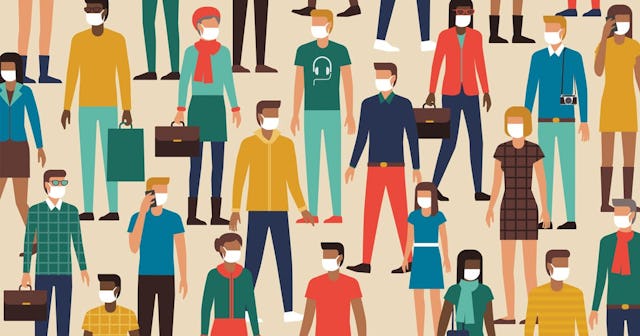6 Things You Need To Know About Herd Immunity And COVID-19

“But it’s good that people are getting infected, it means we’re getting closer to herd immunity!”
Among all the junk science and conspiracy theories about coronavirus, this one is probably the least ridiculous-sounding. I mean, we use vaccines to achieve herd immunity and prevent the spread of contagious diseases like measles and chickenpox. The 1918 flu epidemic ended when the virus finally burned itself out via herd immunity. So why not aim for herd immunity with COVID-19? Why not just let the low-risk people get sick and be done with this thing?
What Herd Immunity Actually Is
The phrase “herd immunity” is thrown around too much when we talk about COVID-19. When epidemiologists talk about herd immunity, especially when it comes to diseases with a high mortality rate like COVID-19, they aren’t usually referring to the natural variety. They’re usually referring to herd immunity via vaccination—when enough people have been vaccinated against an illness that their inability to spread that illness protects those in the population who are unable to be vaccinated.
“Herd immunity” refers to a collective protectionism. As many people as possible get vaccinated, thereby protecting individuals unable to vaccinate—like infants or the immunocompromised. The term “herd” is key here as it mirrors the way herds of animals collectively and cooperatively protect the weakest among them. It’s not “Let a whole bunch of people get sick and die so the virus finally has nowhere else to go, yay, we won!”
The Death Toll Of Herd Immunity For COVID-19
Speaking of death, let’s say for a moment we were to deliberately aim for natural herd immunity against COVID-19. Let’s do that math and see what it would take.
Epidemiologists estimate that herd immunity for COVID-19 would require about 70% of the population to have contracted the virus and be immune.
70% of the population of the United States is 229 million.
As of this writing, 2.6 million Americans have been confirmed to have been infected with COVID-19. However, experts now say, based on serology testing (antibody testing), that the infected number is likely ten times higher than that. It’s easy to see the logic in this since we know many mild or asymptomatic cases would not be confirmed via a COVID-19 test, because why would someone seek a test if they weren’t symptomatic? Also, we were short on tests for several months, so people couldn’t get tested.
So, 2.6 million confirmed, but an estimated 26 million-ish people actually infected. Of those 26 million, so far 126,000 have died (we won’t factor in that of current active cases, many still have yet to die).
Remember, 229 million people must get infected with COVID-19 in order to reach herd immunity. We’re 203 million short—we need nearly eight times this amount. And, based on the current death rate of 126,000 for every 26 million cases of COVID-19, that means that in order to reach herd immunity, we could expect to see 982,000 deaths.
I don’t know about you, but I am not okay with losing a million Americans to COVID-19.
If Herd Immunity Even Works At All
Rob Curran/Unsplash
Scary math scenarios aside, it’s important to note that immunity may not function in COVID-19 as it does with other viruses. Although other coronaviruses, like SARS and MERS, generate antibodies that last for at least a year, in at least one study, COVID-19 antibodies were shown to decrease after only a couple of months. So, until we more fully understand whether or not antibodies following an infection truly provide protection from reinfection, natural herd immunity is not something we should aspire to.
Infection Doesn’t Stop Once We Reach Our Magic “Herd Immunity Number”
The other thing many people don’t realize when they talk about herd immunity is that when we hit this number—this magic 70%—infections don’t simply stop. The final percentage of people infected could end up being as high as 90%. Given the death tolls counted above, this is not a match we want to light.
Unlike Vaccine-Derived Herd Immunity, Natural Herd Immunity Does Not Protect The Most Vulnerable
When I discussed herd immunity above, I talked about how the immunized “herd” is meant to act as a protective layer to prevent transmission to vulnerable community members who cannot be vaccinated. With COVID-19, we’ve been recommending that high-risk individuals, such as those over 65, self-isolate to avoid exposure. Say they actually do this—remain inside while the greater population intentionally gets itself sick to achieve herd immunity. Once a population reaches herd immunity, everyone begins to socialize like before. All it would take is one single infected individual in a retirement community or nursing home to get sick to cause a devastating outbreak within that community. Because, within the community itself, there is no herd protection. They didn’t participate in the drive to natural herd immunity, because they couldn’t. The only way to offer true herd immunity, even within high-risk populations, is with a vaccine.
If Herd Immunity Isn’t The Answer, What Is?
The answer is to do whatever we can to slow the spread of this virus. That means social distancing, avoiding crowds, and wearing a mask when you must go out. It means using common sense. It means listening to experts—actual experts who have the agreement of their peers who are also experts and not some fringe radical who was excommunicated from the scientific community and made a YouTube video. It means giving a shit about your fellow humans. It means not acting like an entitled asshole. It means doing all of these things, and it means doing these things until the thousands of scientists working on this thing around the clock come up with either a vaccine or an effective treatment.
This article was originally published on